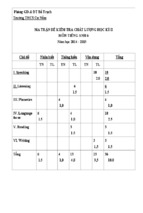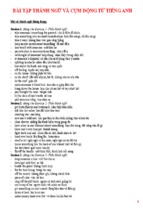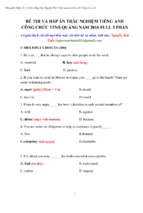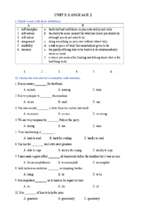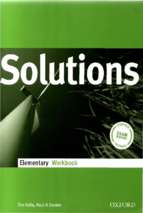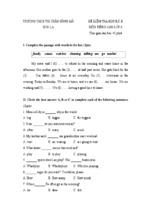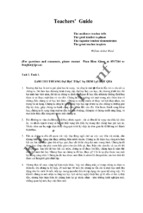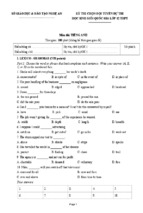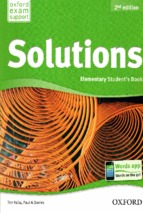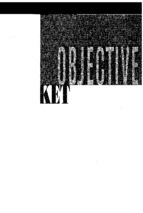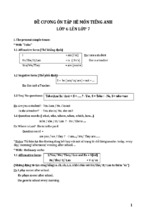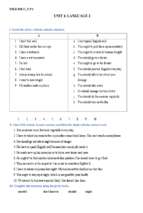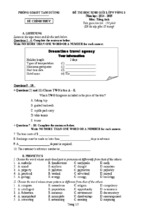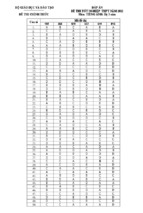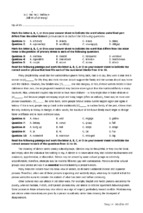������������
Want to learn more?
We hope you enjoy this
McGraw-Hill eBook! If
you’d like more information about this book,
its author, or related books and websites,
please click here.
Thuvientailieu.net.vn
For more information about this title, click here
Contents
vii
Introduction
Unit 1
Nouns
1
Unit 2
Definite and Indefinite Articles
6
Unit 3
Adjectives
9
Unit 4
Personal Pronouns
12
Unit 5
Verbs
17
Unit 6
Auxiliary Verbs
44
Unit 7
Passive Voice
49
Unit 8
Subjunctive Mood
53
Unit 9
Adverbs
59
Unit 10
Contractions
62
Unit 11
Plurals
65
Unit 12
Punctuation
68
Unit 13
Infinitives and Gerunds
75
Unit 14
Relative Pronouns
77
Unit 15
Reflexive Pronouns
83
Unit 16
Possession
86
Unit 17
Possessive Pronouns
88
Unit 18
Prepositions
92
Unit 19
Capitalization
95
Unit 20 Comparative and Superlative Forms
Unit 21
99
Conjunctions
106
Unit 22 Interrogatives
110
v
Thuvientailieu.net.vn
vi
Contents
Unit 23 Negation
115
Unit 24 Numbers
120
Unit 25 Some Important Contrasts
125
Appendix: Common Irregular Verbs
133
Answer Key
135
Thuvientailieu.net.vn
Introduction
Many people consider learning grammar a chore. And at times, it can be. But understanding the
grammar of any language is essential for becoming a skilled and accurate user of that language.
English is certainly no exception.
The rules of grammar for a language learner are like the rules of the road for a driver. In order
to be able to drive properly and maneuver with other drivers, you have to know the rules that
everyone goes by. Naturally, some people break the rules and make driving difficult for other
drivers. This is true of language, too. If you follow the rules of grammar, you can express yourself
clearly. But if you fail to observe those rules, people may find it difficult to understand you or
they may even misunderstand you entirely. So it’s really very important to understand and use
correct grammar.
But what is grammar? Funk and Wagnalls’s New College Standard Dictionary describes grammar as
“a type of science that explains the various principles of oral or written usage of a particular language.” It is also said to be “the developed art of speaking or writing accurately in a particular
language.” Whether science or art, grammar is made up of the descriptions that tell you how to
use a language correctly. For example:
Description: Begin a sentence with do to change a statement to a question.
Usage: Statement = “You understand the problem.”
Question = “Do you understand the problem?”
Or:
Description: Use he as the subject of a sentence; use him as the direct object.
Usage: Subject = “He is a good friend of mine.”
Direct Object = “I visit him very often.”
There are many such grammatical descriptions, and each one is a building block in the structure
of your knowledge of how to form and use English correctly. The greater the number of building blocks that you master, the greater your accuracy with the spoken and written language will
be.
Standard grammar is composed of the traditional rules for English. It is what grammarians and
English professors want everyone to use when they speak and write. But a language evolves over
time, and the traditional rules sometimes seem out of step with what is going on in the Englishspeaking world. The more current or popular usages can be called casual language. That’s what
people really say in their everyday lives and is often in direct contradiction with standard grammar. As an illustration, in standard grammar you should use who as the subject of a sentence and
use whom when it is used as an object. But that’s not always the case in casual language. For
example:
Standard grammar: “Whom did you visit in New York?”
Casual language: “Who did you visit in New York?”
vii
Copyright © 2005 by The McGraw-Hill Companies, Inc. Click here for terms of use.
Thuvientailieu.net.vn
viii
Introduction
Although the first example is considered better grammatically, the second example sentence is
the most commonly used.
Another kind of example involves the verb to dive. Its past tense is either regular (dived) or irregular (dove). What is the difference? Essentially, none. Both forms are used correctly as the past
tense. But English is evolving. Things are changing. And the English-speaking world is deciding
whether it wants the past tense of the verb to dive to be regular or irregular. It may take quite a
while longer to learn what that decision will be. So for the time being you’ll continue to hear
both dived and dove in the past tense.
There is a similar case with the verb to prove. Nowadays, many people use proved as the participle
in a perfect tense: “He has proved” or “We had not proved.” But there are others who still use
the archaic form (proven), which today is generally accepted as an adjective, in place of proved:
“He has proven” or “We had not proven.”
The point here is that grammar rules will guide you toward speaking and writing better English.
But many rules of grammar are broken by certain casual or popular usages and still others
become unclear because the language is in a state of transition. Where these deviations occur,
they will be discussed in this book, because if English learners only know that who should be used
as a subject of a sentence, they will be confused by what occurs in casual language: “Who did you
visit in New York?”
However, just knowing the rules of grammar is not enough. This book will also provide you with
abundant practice in using English grammar. The more you practice, the more you become proficient in how you use English and to what extent you understand it. There are various kinds of
exercises to allow you to manipulate the language from different angles. The Answer Key at the
end of the book gives you not only the right answers but also suggestions as to how an exercise
should be completed.
English grammar isn’t necessarily a chore. Indeed, it can be your key to unlocking a very rich
treasure.
Thuvientailieu.net.vn
Unit 1
Nouns
Nouns can be either proper or common. Proper nouns are those that
refer to a particular person, place, thing, or idea. Such nouns are
capitalized: America, George Washington, Mr. Neruda, October.
Nouns that do not refer to a particular person, place, thing, or idea
are common nouns. They are not capitalized: land, girls, money, test.
Compare the following list of proper and common nouns:
Proper Nouns
Common Nouns
Mexico
Ms. Finch
English
McGraw-Hill
American Airlines
December
country
woman
language
publisher
company
month
exercise
1-1
Next to each noun write the word proper or common.
1.
France
2.
rope
3.
United States
4.
Professor Hall
5.
professor
6.
the stadium
7.
the Olympics
8.
horses
1
Copyright © 2005 by The McGraw-Hill Companies, Inc. Click here for terms of use.
Thuvientailieu.net.vn
2
Practice Makes Perfect: English Grammar for ESL Learners
9.
Dr. Blanchard
10.
our school
exercise
1-2
Rewrite each noun, capitalizing the proper nouns.
1.
glass
2.
rocky mountains
3.
mexico
4.
flowers
5.
bus
6.
the store
7.
new york times
8.
roberto
9.
professor romano
10.
my books
Nouns can be used as the subject of a sentence. The subject is the word that is performing the
action in the sentence. The subject can be a proper noun or a common noun, and it can be singular or plural:
Juanita is a friend of mine.
The boys like to play soccer.
Where is the school?
Nouns can also be used as direct objects. The direct object in a sentence is the noun that receives
the action of the verb. To find the direct object in a sentence do three things:
1. Find the subject of the sentence.
2. Find the verb in the sentence.
3. Ask whom or what with the subject and the verb.
Look at these sample sentences:
“Sara likes my brother.”
“The girls find a book.”
1. subject � Sara
2. verb � likes
1. subject � girls
2. verb � find
Thuvientailieu.net.vn
Nouns
3. ask whom � Whom does
Sara like?
3. ask what � What do the
girls find?
The direct object is my brother
The direct object is book.
3
Nouns are sometimes indirect objects. They stand before the direct object in the sentence. It is the
person to whom or for whom something is provided. To find the indirect object in a sentence
do three things:
1. Find the subject of the sentence.
2. Find the verb in the sentence.
3. Ask to whom or for whom with the subject and the verb.
Look at these sample sentences:
“Justin buys the girl a magazine.”
“Mother gives Nate five dollars.”
1. subject � Justin
2. verb � buys
3. ask to whom or for whom � For
whom does Justin buy a magazine?
1. subject � Mother
2. verb � gives
3. ask to whom or for whom � To whom
does Mother give five dollars?
The indirect object is girl.
The indirect object is Nate.
Note: It is rare that something inanimate is used as an indirect object.
When a noun is used as a predicate noun, it follows the predicate in the sentence. The predicate
can be a single verb or a verb phrase:
Verb as the predicate: Maria helps us.
Verb phrase as the predicate: Maria usually helps with the gardening.
Predicate nouns most often follow the verbs to be and to become:
My mother wants to be a doctor.
Celine became an actress.
Are you the manager of this building?
exercise
1-3
Look at the italicized word in each sentence. Decide how it is used, then write subject, direct object, indirect
object, or predicate noun in the blank.
1.
Claudia likes Bret.
2.
The boys found some money.
3.
The girls found some money.
4.
My father is an engineer.
5.
I sent my sister a telegram.
6.
Tomas buys Serena three red roses.
Thuvientailieu.net.vn
4
Practice Makes Perfect: English Grammar for ESL Learners
7.
Is the woman at home now?
8.
Mr. Jimenez became a pilot.
9.
He needs a new car.
10.
Carmen gives them the books.
exercise
1-4
Write a sentence using the noun given as a direct object.
EXAMPLE: the boy
Barbara sees the boy in the park.
1. my sister
2. a new car
3. Jackie
Write a sentence using the word given as an indirect object.
4. the children
5. a puppy
6. Grandfather
exercise
1-5
Using the phrase in parentheses, answer each question using that phrase as the direct or indirect object.
EXAMPLE: (Yolanda) Whom does Gerry meet?
Gerry meets Yolanda.
1. (the boys) Whom does the girl not trust?
Thuvientailieu.net.vn
Nouns
2. (his wallet) What does Father often misplace?
3. (the landlord) To whom does she always give the rent money?
4. (her new computer) What does Anita want to sell soon?
5. (her grandchildren) For whom does she buy the toys?
6. (Ms. Johnson) Whom must you visit in New York?
7. (their new house) What do they like so much?
8. (little Johnny) To whom can she give the present?
9. (Dr. Lee) Whom does he need to see today?
10. (Michael) To whom does she throw the ball?
Thuvientailieu.net.vn
5
Unit 2
Definite and Indefinite
Articles
The English definite article is the. It is used to identify a particular
person or thing. If you are speaking about someone or something
you are already familiar with, you use the with the noun. Look at
these examples:
I already know the man.
She met the women who won the lottery.
This is the book that I told you about.
The indefinite article is used to describe someone or something
that is unfamiliar to you or about which you are speaking in
general. There are two forms: a and an. Use a before a word
beginning with a consonant. Use an before a word beginning with
a vowel. Look at these examples:
He sees a stranger on the corner.
Did you buy an apple or an orange?
Is the woman a good lawyer?
She has an idea.
Compare the difference between the definite and indefinite article
by using these sentences:
I want an apple. (I do not see an apple. But I feel hungry for
one.)
I want the apple. (I am choosing between the apple and the
orange that I see before me.)
The definite article for plural nouns is also the. But there is no
indefinite article for plural nouns. The plural articles are used in
the same way as the singular articles.
6
Copyright © 2005 by The McGraw-Hill Companies, Inc. Click here for terms of use.
Thuvientailieu.net.vn
Definite and Indefinite Articles
Singular Definite
Singular Indefinite
Plural Definite
Plural Indefinite
the boy
the house
the idea
a boy
a house
an idea
the boys
the houses
the ideas
boys
houses
ideas
exercise
2-1
Fill in the blank with either the definite or indefinite article, whichever makes the best sense.
1. Did you buy a Ford or
Chevy?
2. Does he know
man on the corner?
3. She has
secret to tell you.
4. What time does
train leave?
5. We need
hot dogs and a bottle of Coke.
6. Did you see
accident?
7. He met
8.
guests as they arrived.
teacher is angry with us.
9. I can’t find
keys.
10. Is that _______ snake in that tree?
exercise
2-2
Rewrite each sentence, changing the singular nouns in each sentence to plural nouns. Make any changes to the
articles and verbs that are necessary.
1. They gave us an orange.
2. I like the book very much.
3. Do you often visit the farm there?
Thuvientailieu.net.vn
7
8
Practice Makes Perfect: English Grammar for ESL Learners
4. A rabbit is hiding behind it.
5. Katrina likes to play with the kitten.
Follow the same directions, but change the plural nouns to singular.
6. Montel has dogs and cats.
7. I want to buy the roses.
8. There are gifts for you.
9. Can you hear the babies crying?
10. Do you have brothers or sisters?
Thuvientailieu.net.vn
Unit 3
Adjectives
Adjectives are words that describe nouns. They tell the size, color,
or quality of something: a big room, the red car, four interesting
books. Here are some commonly used adjectives:
beautiful
fast
loud
tall
big
funny
old
terrible
black
handsome
quiet
thirsty
boring
interesting
right
ugly
careful
late
sad
young
careless
little
short
white
early
long
slow
wrong
exercise
3-1
Circle the adjective that makes more sense in the sentence.
1. I often go to a green/late movie.
2. Their little/right boy is six years old.
3. The wrong/young teacher is very smart.
4. We took the fast/loose train to New York.
5. The old/funny story made me laugh.
6. Do you know that handsome/early man?
7. She had an early/careless breakfast.
8. I saw the long/terrible accident.
9. The new house has boring/white doors.
10. The green/short boy is my cousin.
9
Copyright © 2005 by The McGraw-Hill Companies, Inc. Click here for terms of use.
Thuvientailieu.net.vn
10
Practice Makes Perfect: English Grammar for ESL Learners
Just like nouns, adjectives can follow the predicate. They most often come after forms of the
verbs to be and to become :
My sister was very sad.
The horse suddenly became thirsty.
My grandfather is old.
exercise
3-2
Look at the example sentences. Change each sentence so that the adjective follows the predicate.
EXAMPLE: The white house is on the hill.
The house on the hill is white.
1. The sad song was from Mexico.
2. The funny story is about a clown.
3. The careless waiter is out of work.
4. The ugly snake is from Egypt.
5. The beautiful woman is from Spain.
exercise
3-3
Fill in the blank with any adjective that makes sense. You may choose from the list given at the beginning of the
unit.
1. David wrote a
2. Do you like the
poem for her.
cake?
3. I cannot find an
book.
4. Where does the
lawyer live?
5. Marisa needs a
6. The
job.
man found a
Thuvientailieu.net.vn
wallet.
Adjectives
7. Kareem is a
8. There is a
friend of mine.
test tomorrow.
9. When can you come to our
10. That is a
farm?
question.
Thuvientailieu.net.vn
11
Unit 4
Personal Pronouns
Pronouns are words that take the place of nouns. The English personal pronouns are:
First Person
Second Person
Third Person
Singular
Plural
I
you
he, she, it
we
you
they
Notice that you is both singular and plural. When speaking to one
person, say you. When speaking to two or more persons, say you:
Tim, you are a very good student.
Bruno and Rene, you have to study more.
Just as nouns have gender, pronouns also do. I, we, and you can be
used by males or females. He is always masculine, she is always feminine, and it is always neuter. The plural of the third-person pronouns is always they, whether masculine, feminine, or neuter. And
just like nouns, pronouns can be used as:
1. the subject of a sentence
2. a direct object
3. an indirect object
But when used as a direct object or indirect object, some of the
pronouns change:
Subject
Direct Object
Indirect Object
I
you
he
she
it
we
you (plural)
they
me
you
him
her
it
us
you
them
me
you
him
her
it
us
you
them
12
Copyright © 2005 by The McGraw-Hill Companies, Inc. Click here for terms of use.
Thuvientailieu.net.vn
Personal Pronouns
13
If a pronoun replaces a noun in the sentence, it must have the same characteristics as the noun:
the same number (singular or plural), the same gender (masculine, feminine, or neuter), and
the same use in the sentence (subject, direct object, or indirect object). Look at these examples
where the pronoun replaces the italicized noun:
Joseph is a hard worker.
(singular masculine noun/subject)
➞
He is a hard worker.
(singular masculine pronoun/subject)
Do you know the girls?
(plural noun/direct object)
➞
Do you know them?
(plural pronoun/direct object)
We gave Mrs. Jones some flowers.
(singular feminine noun/
indirect object)
➞
We gave her some flowers.
(singular feminine pronoun/
indirect object)
Notice that the nouns and pronouns are in the third person. This is true when a pronoun
replaces a noun. But when a noun or pronoun is combined with the first-person singular pronoun I, it is replaced by the first-person plural pronoun we :
You and I have work to do. ➞ We have work to do.
He helps the girls and me. ➞ He helps us.
exercise
4-1
Look at the pronoun given in parentheses. Fill in the blank in the sentence with its correct form.
1. (you) How are
today?
2. (he) Caleb gave
3. (she)
a gift.
lives on Main Street.
4. (it) I really don’t like
5. (I) She met
6. (Kris and I) Please give
7. (you and I)
8. (they) Are
9. (we) The puppy followed
10. (they) My brother saw
11. (you) Mikhail wants to visit
12. (I) When can
13. (it) Derrick bought
.
in the city.
the magazines.
worked in the garden.
your friends?
home.
in New York.
today.
move into the apartment?
in Mexico.
Thuvientailieu.net.vn
14
Practice Makes Perfect: English Grammar for ESL Learners
14. (you and I) The children are helping
15. (she) I like
exercise
.
a lot.
4-2
Change the italicized noun in each sentence to the corresponding pronoun.
1. The students came to class late.
2. I found the money in the closet.
3. Her brother sent Jennifer and me a postcard.
4. Do your parents live in Florida?
5. My landlady is very nice.
6. Do you know my landlady?
7. Boys can get so dirty.
8. Did you lose your wallet?
9. Juan visits his uncle often.
10. May I borrow your watch?
exercise
4-3
Change the italicized pronoun in each sentence to any appropriate noun.
1. We often speak English.
2. Do you like it?
3. Where did you find them?
4. She is from Puerto Rico.
5. Patricia never met him before.
6. Is he sick today?
7. We sent them a box of candy.
8. It costs twenty dollars.
Thuvientailieu.net.vn
- Xem thêm -

